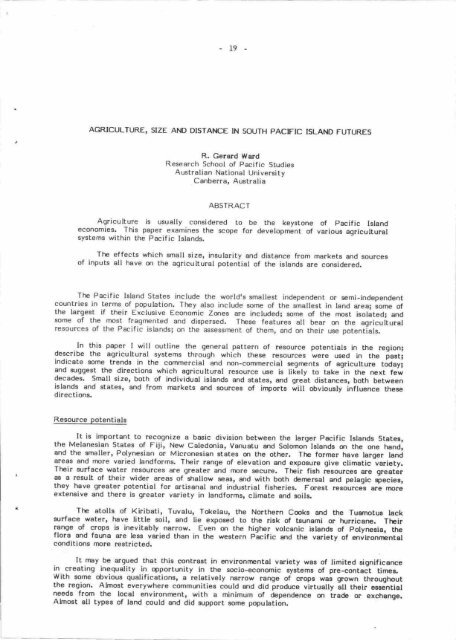Rt€@lll
Rt€@lll
Rt€@lll
Create successful ePaper yourself
Turn your PDF publications into a flip-book with our unique Google optimized e-Paper software.
-19<br />
AGRICULTURE' slzE AND DIsTAtlcE IN SOUTH PActFIc ISLAND FUTURES<br />
R. Gerard Werd<br />
Research School of pacifie Studies<br />
Australian National University<br />
Canberra, Australia<br />
ABSTRACT<br />
Agriculture is usually considered Eo be the keystone of Pacific Island<br />
economies- This paper examines the scope for developrnent of various agricultural<br />
systems within the Pacific Islands.<br />
The effeets which small size, insularity and distance from markets and sources<br />
of inputs all have m the agricultural potential of the islands are considered.<br />
The Pacific Island States include the worldrs smallest independent or semi-independent<br />
countries in terms of population. They also include some of the smallest in land area; some of<br />
the largest if their Exclusive Eeonomic Zones are included; some of the most isolated; and<br />
some of the most fr-agmented and dispersed. These features all bear on the agricuitural<br />
resources of the Pacific islands; on the assessrnent of them, and on their use potentials.<br />
ln this paper I will outline the general pattern of resource potentials in the regionl<br />
describe the agricultural systems through which these resources were used in the i".t;<br />
indicate some trends in the commercial and non-commercial segnnnts of agriculture todayi<br />
and zuggest the directions which agricultural resource use is lkLly to take in the next few<br />
decades. Small size, both of individual islands and states, and great distances, both between<br />
islands and states' and from markets and sources of importe witl obviously influence these<br />
directions.<br />
Resource potentials<br />
It is important to recognize a basic division between the larger Pacific Islands Statea,<br />
the Melanesian States of Fiji, New Caledonia, Vanuatu and Solomon Islands m the one handi<br />
and the smaller, Polynesian or Micronesian states m the other. The former have larger hnj<br />
areas and rnore varied landforms. Their range of elevation and exposure give climatic variety.<br />
Their surface water resources are greater and rmre secure. Their fish rlsources are greater<br />
as a result of their wider areas of shallow seas, and with both denrersal end pelagic $ecies,<br />
they have greater potential for artisanal and industrial fieheriee. Fmest resources are rxrre<br />
extensive and there is greater variety in landforms, climete and soils.<br />
Tfe atolls of Kiribati, Tuvalu, Tokelau, the Northern Coks end the Tuemotus lack<br />
surface water, have little soil, and lie exposed to the risk of teunami or hurricane. Tfeir<br />
range of crops is inevitably narrow. Even m the higher volcenic iglends of polynesia, the<br />
flora and faune ere less varied than in the western pacitic and the variety of environrental<br />
conditions more restricted.<br />
It may be argued thet thig eontrast in environnental variety was of timited aignificance<br />
in<br />
.<br />
creating inequality in opportunity in the socio-econornic ayslem. of pre-contact timea.<br />
With eome obvious qualifications, a relatively narrow range of ctopa was grown throughout<br />
the region. Almost everywhere communitieg could end did produce virtually elt ttreir aesential<br />
needs from the local environnent, with a minimum of dependence on -trade or exchenge.<br />
Alrnost all types of lend could and did a.rpport some population.














![R]€@lll](https://img.yumpu.com/7594335/1/175x260/reurlll.jpg?quality=85)
